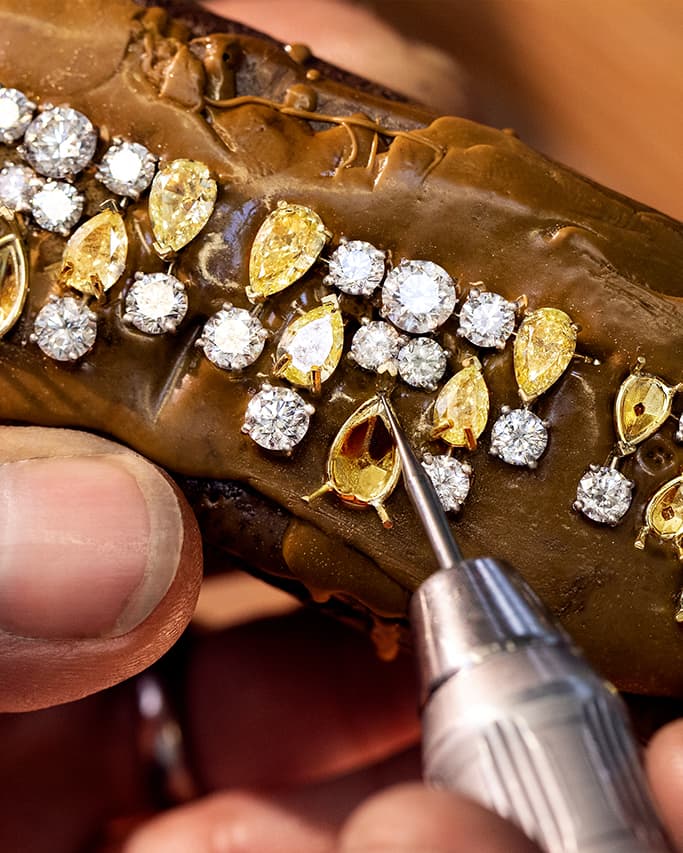There is a story about a yellow diamond. In 1867, a 15-year-old boy named Erasmus Stephanus Jacobs lived with his family in North Cape, South Africa. On the banks of the Orange River, he found a sparkling stone. Some say his father took it to an expert. Others say his mother simply gave it away. It passed through a series of hands, was eventually bought for £500, and was declared the first diamond discovered in South Africa - triggering a subsequent rush for the precious gems.
The ‘Eureka diamond’ is often referred to as the world’s first yellow diamond. This is apocryphal (two centuries previously the French merchant Jean-Baptiste Tavernier travelled through India, noting a stunningly saturated 137.27ct stone he referred to as ‘The Florentine’ and ‘The Grand Duke of Tuscany’) but the Eureka was among the first to be properly authenticated - and cemented the appeal of this singularly coloured stone.
British jeweller Graff have a long and dazzling history of working with yellow diamonds
Their own prized stones include The Star of Bombay, a 47.39 carat yellow diamond acquired, cut and polished by founder Laurence Graff in 1974, as well as the Delaire Sunrise, a 118.08 carat gem certified as the largest Fancy Vivid Yellow square emerald-cut diamond in the world.

Yellow diamonds come in many shades, from pale lemon to a rich, yolky gold. They are created by the presence of nitrogen: the more nitrogen, the more colour.

Where a white diamond is prized for clearness, a yellow diamond becomes valuable for its intensity. The former is graded by the ‘Four C’s’: cut, colour, clarity, and carat. Although these are important to yellow diamonds, the latter has its own scale: hue, tone, saturation, and distribution of colour. The GIA (Gemological Institute of America) uses a set of grades that begin with ‘faint’ and end with ‘fancy dark’ and ‘fancy deep’.






For Anne-Eva Geffroy, design director at Graff, yellow diamonds are thrilling to work with. “It's like a piece of the sun has been trapped in it,” she says. “And like the sun during the day, you have different hues.” Some stones are reminiscent of morning light. Others recall “the middle of lunchtime when the sun is very intense.” Geffroy’s job is to envision what happens with Graff’s stones. Will they form a necklace? How best to show off a perfect pair? “We’re lucky to work with the best colour,” she adds. “What we do as designers is create a balance that… is always in service of the yellow.”
The design process begins with observation of the gem. Whether it’s a single stone ready to become the star of the show, or an array of yellow diamonds destined for a bracelet, it’s a question of how to accentuate each element. This requires an intuitive understanding: an ability to see “every single facet” and appreciate how to “keep the colour or make it even better.” Oval, radiant and cushion cuts are often used for this reason, and yellow diamonds are often combined with white to increase their spectacular appearance.
All designs are hand-sketched from multiple angles before they become CADs (computer aided designs), envisioned in 3D. “You need to feel the emotion,” Geffroy explains. She variously refers to this process as a rhythm, a form of music, and theatre. Designing jewellery requires one to be an architect, but also a composer, paying keen awareness to mood, harmony, crescendo, and drama. “It can be very modern… pure and simple,” Geffroy adds. “Or part of a symphony of creation with different shapes and motifs.”
For the designer “every creation is an event.” Events they may be, but the house style is not all-out spectacle. Instead, it is subtler. Restrained or elaborate, these designs fuse timeless beauty with an awareness of how jewels are actually worn. A pair of high carat yellow diamond drop earrings, for example, don’t need to be weighed down by heavy metals. With the workshop just downstairs, a designer can work in tandem with the crafters – paring back to let the stones sing.

“It's about how the stone is going to live its second life,” Geffroy says. “This stone was in the earth for billions of years… and we brought it back to the light… It’s our turn to offer it the joy of living again.”

